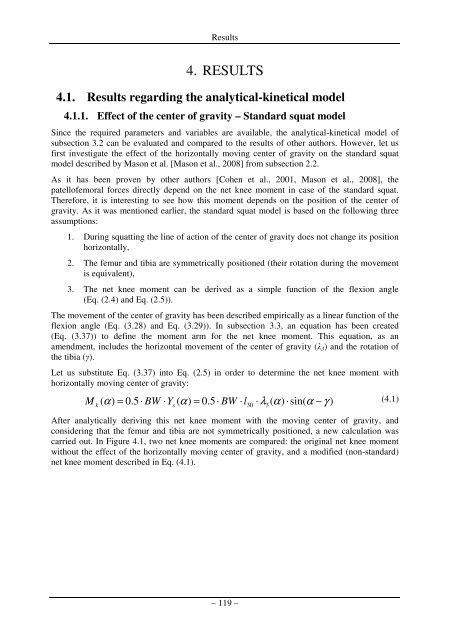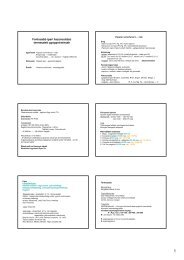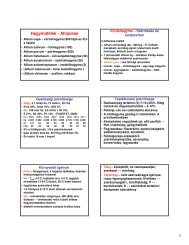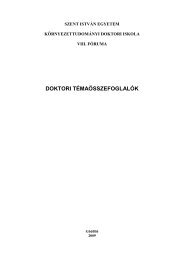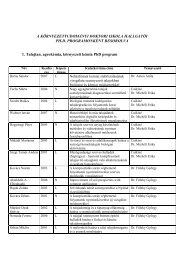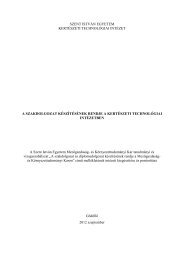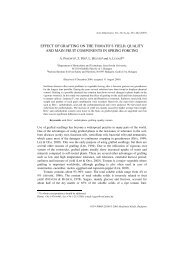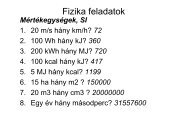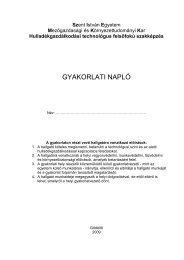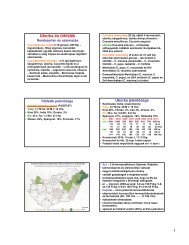PhD Fekete - SZIE version - 2.2 - Szent István Egyetem
PhD Fekete - SZIE version - 2.2 - Szent István Egyetem
PhD Fekete - SZIE version - 2.2 - Szent István Egyetem
Create successful ePaper yourself
Turn your PDF publications into a flip-book with our unique Google optimized e-Paper software.
Results<br />
4. RESULTS<br />
4.1. Results regarding the analytical-kinetical model<br />
4.1.1. Effect of the center of gravity – Standard squat model<br />
Since the required parameters and variables are available, the analytical-kinetical model of<br />
subsection 3.2 can be evaluated and compared to the results of other authors. However, let us<br />
first investigate the effect of the horizontally moving center of gravity on the standard squat<br />
model described by Mason et al. [Mason et al., 2008] from subsection <strong>2.2</strong>.<br />
As it has been proven by other authors [Cohen et al., 2001, Mason et al., 2008], the<br />
patellofemoral forces directly depend on the net knee moment in case of the standard squat.<br />
Therefore, it is interesting to see how this moment depends on the position of the center of<br />
gravity. As it was mentioned earlier, the standard squat model is based on the following three<br />
assumptions:<br />
1. During squatting the line of action of the center of gravity does not change its position<br />
horizontally,<br />
2. The femur and tibia are symmetrically positioned (their rotation during the movement<br />
is equivalent),<br />
3. The net knee moment can be derived as a simple function of the flexion angle<br />
(Eq. (2.4) and Eq. (2.5)).<br />
The movement of the center of gravity has been described empirically as a linear function of the<br />
flexion angle (Eq. (3.28) and Eq. (3.29)). In subsection 3.3, an equation has been created<br />
(Eq. (3.37)) to define the moment arm for the net knee moment. This equation, as an<br />
amendment, includes the horizontal movement of the center of gravity (λ 3 ) and the rotation of<br />
the tibia (γ).<br />
Let us substitute Eq. (3.37) into Eq. (2.5) in order to determine the net knee moment with<br />
horizontally moving center of gravity:<br />
M<br />
k<br />
( α)<br />
= 0.5⋅<br />
BW ⋅Ys<br />
( α)<br />
= 0.5⋅<br />
BW ⋅l30 ⋅ λ3(<br />
α)<br />
⋅sin(<br />
α − γ )<br />
(4.1)<br />
After analytically deriving this net knee moment with the moving center of gravity, and<br />
considering that the femur and tibia are not symmetrically positioned, a new calculation was<br />
carried out. In Figure 4.1, two net knee moments are compared: the original net knee moment<br />
without the effect of the horizontally moving center of gravity, and a modified (non-standard)<br />
net knee moment described in Eq. (4.1).<br />
– 119 –


